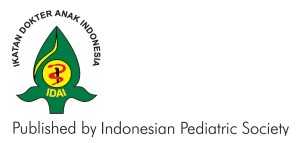Forced expiratory volume in 1-second and blood gas analysis in children during asthma attacks
Abstract
Background Asthma is the most common chronic disease in the world, with a high incidence in children. Blood gas analysis and pulmonary function test using spirometry are recommended to evaluate the degree of asthma in children. Spirometry test is non-invasive and easier to implement compared to blood gas analysis.
Objective To evaluate for a possible correlation between forced expiratory volume in 1 second (FEV1) measured by spirometry test and blood gas analysis (pO2 and pCO2 levels) in children during an asthma attack.
Methods This cross-sectional study was done in children with asthma attacks who were admitted to Sanglah Hospital, Denpasar, Bali, between November 2016 and April 2017. Subjects underwent spirometry tests and blood gas analyses. Potential correlations between FEV1 and pO2 and pCO2 levels were analyzed by Spearman’s correlation test.
Results A total of 50 subjects, consisting of children aged 6 to 12 years, were diagnosed with asthma attacks during the study period. Subjects’ mean FEV1 level was 43.6%, mean pCO2 was 38.36 mmHg, and mean pO2 was 121.92 mmHg. There were no significant correlations between FEV1 and pCO2 level (r=0.206; P=0.152) or FEV1 and pO2 (r=0.157; P=0.277) found in this study.
Conclusion FEV1 does not correlate with pCO2 and pO2 level in children during asthma attacks.
References
Global Initiative for Asthma. Global Strategy for Asthma Management and Prevention. Geneva: GINA. 2015 August; [cited 2016 January 12]. Available from: http://www.ginasthma.org.
Gerald LB, Grad R, Turner-Henson A, Hains C, Tang S, Feinstein R, et al. Validation of a multistage asthma case-detection procedure for elementary school children. Pediatrics. 2004;114:459-68.
Oemati R, Sihombing M, Qomariah. Faktor-faktor yang berhubungan dengan penyakit asma di Indonesia. Media Litbang Indonesia. 2010;20:41-9.
Yosefy C, Hay E, Nasri Y, Magen E, Reisin L. End tidal carbon dioxide as a predictor of the arterial PCO2 in the emergency department setting. Emerg Med J. 2004;21:557-9.
Cabana M, Slish K, Nan B, Leo H, Bratton SL, Dombkowski KJ. Outcomes associated with spirometry for pediatric asthma in a managed care organization. Pediatrics. 2006;118:151-6.
Brower AF, Roorda RJ, Duiverman EJ, Brand PL. Reference values for peak flow and FEV1 variation in healthy schoolchildren using home spirometry. Eur Respir J. 2008;32:1262-8.
Kartasasmita CB, Supriyatno B, Wahyudin B, Makmuri MS, Nataprawira HM, Rahajoe NN. Asma. In: Rahajoe NN, Supriyatno B, Setyanto DB, editors. Buku ajar respirologi anak. 1st ed. Jakarta: BP IDAI; 2013. p. 71-147.
Fard MR, Zarezadeh N. Relationship between FEV1 and PaO2, PaCO2 in patients with chronic bronchitis. Tanaffos. 2004;3:41-6.
Shibel EM, Moser KM. The relation between spirometric measurements and arterial blood gas analysis in patients with chronic airflow obstruction. Thorax. 1970;25:598-603.
Harsono A, Kusumawardani S, Makmuri MS, Santosa G. Airway reversibility in newly developed asthma in children. Paediatr Indones. 2003;43:1-5.
Padmavathi K, Sumangali P, Subash Y. Arterial blood gas analysis in acute and chronic bronchial asthma. Bull Pharm Med Sci. 2013;1:200-6.
Rahajoe NR, Supriyatno B, Setyanto DB. Pedoman nasional asma pada anak. 2nd ed. Jakarta: BP IDAI; 2015. p. 1-47.
Thomas AE, Peter WH. Immunopathogenesis of asthma. In: Chernick V, Boat TF, Wilmott RW, Andrew B, editors. Kendig’s Disorders of the respiratory tract in children. 3rd ed. New York: Elsevier; 2006. p. 762-839.
Hamasaki Y, Kohno Y, Ebisawa M, Kondo N, Nishima S, Morikawa A, et al. Japanese guideline for childhood asthma 2014. Allerg Int. 2014;63:335-56.
Kiley J. Expert panel report 3: guidelines for the diagnosis and management of asthma. National asthma education and prevention program. 1st ed. New York: NHLBI; 2007. p. 1-440.
Chung KF, Wenzel SE, Brozek JL, Bush A, Castro M, Sterk PJ, et al. International ERS/ATS guidelines on definition, evaluation and treatment of severe asthma. Eur Respir J. 2014;43:343-73.
Lundstrom KE. The blood gas handbook. Radiometer. 1st ed. Denmark: NCHL; 2011. p. 2-112.
Fuhlbrigge AL, Weiss ST, Kuntz KM, Paltiel AD. Forced expiratory volume in 1 second percentage improves the classification of severity among children with asthma. Pediatrics. 2006;118:347-55.
Copyright (c) 2018 Dewa Ayu Dini Primashanti, Putu Siadi Purniti, I Gusti Ayu Trisna Windiani

This work is licensed under a Creative Commons Attribution-NonCommercial-ShareAlike 4.0 International License.
Authors who publish with this journal agree to the following terms:
Authors retain copyright and grant the journal right of first publication with the work simultaneously licensed under a Creative Commons Attribution License that allows others to share the work with an acknowledgement of the work's authorship and initial publication in this journal.
Authors are able to enter into separate, additional contractual arrangements for the non-exclusive distribution of the journal's published version of the work (e.g., post it to an institutional repository or publish it in a book), with an acknowledgement of its initial publication in this journal.

This work is licensed under a Creative Commons Attribution-NonCommercial-ShareAlike 4.0 International License.
Accepted 2018-09-27
Published 2018-10-04












